55 results
7th grade chemistry simulation pdfs
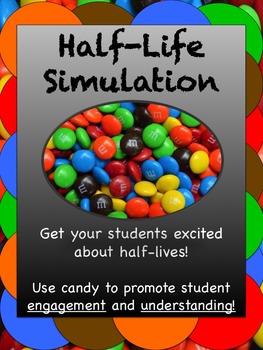
Half-Life Lab: Use a Candy Simulation to Teach Radioactive Decay!
Let your students explore the concept of half-lives while enjoying candy! This simulation can serve as an introduction to the topic or as a piece of reinforcement. Not to mention, your students will be gaining experience using a data table to build their graphing skills!
This purchase includes a teacher instructions page, student lab pages, and an answer key for teachers! Don't let your students get bored during your chemistry or geology unit!
Subjects:
Grades:
6th - 11th

PhET Simulation Online Lab: Build an Atom
In this inquiry-based PhET online lab your students will investigate atomic structure and the subatomic particles that make up atoms using the Build an Atom simulation. They will learn the important terms used to describe atoms such as atomic number, mass number and net charge. They will also be introduced to the layout of the periodic table and how to locate elements on it. Students love working with the online simulations from PhET Interactive Simulations. The Build an Atom simulation is easy
Subjects:
Grades:
7th - 10th, Adult Education
Types:
Also included in: Growing Bundle: PhET Simulations Online Physics and Chemistry Labs
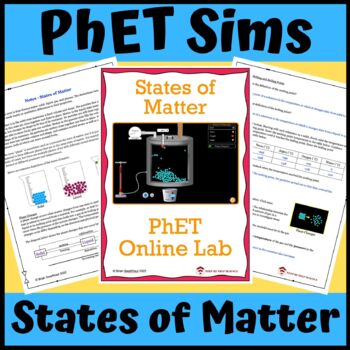
PhET Simulation Online Lab: States of Matter
In this guided inquiry PhET online lab your students will investigate the three states of matter: solids, liquids and gases. By the end of this online lab students will be able to (1) describe the characteristics of the three states of matter, (2) compare the motion of the particles in the three different phases, (3) explain how to change the state of a material and be able to name the six different phase changes (4) understand that different substances have different melting and boiling tempera
Subjects:
Grades:
7th - 10th, Adult Education
Types:
Also included in: Growing Bundle: PhET Simulations Online Physics and Chemistry Labs
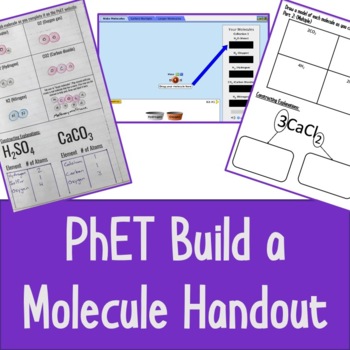
PhET Build a Molecule Student Handout, NGSS MS-PS1-1 Aligned
This resource should be used alongside the PhET Build a Molecule online simulation, in order for students to investigate how written chemical formulas correspond to the number of atoms, types of elements, and amount of molecules in a formula. This resource is a PDF file. I also include a link to a Google Doc version, if you prefer to use that format. This lesson is aligned with NGSS MS-PS1-1: Develop models to describe the atomic composition of simple molecules and extended structuresIncluded:Ov
Subjects:
Grades:
5th - 8th
Types:
NGSS:
MS-PS1-1
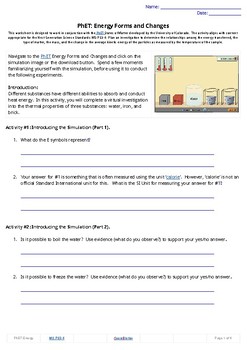
PhET - Energy Forms and Changes
This worksheet aligns with the PhET simulation of the same name, and is applicable for teaching the Next Generation Science Standards (NGSS), MS-PS3-4.
PhET, founded in 2002 by a Nobel Laureate, develops web-based math and science simulations. PhET is currently among one of the most utilized sources for science and math teachers using interactive simulations.
The Build A Molecule simulation and worksheet takes students through activities designed to build and deepen understanding of how at
Subjects:
Grades:
7th - 12th
Types:
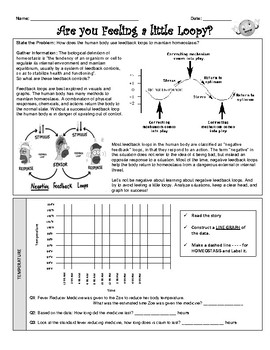
Homeostasis: Are you Feeling a Little Loopy?
Students explore HOMEOSTASIS and FEEDBACK LOOPS through a series of graph explorations. The lesson is designed to allow for graphing practice but guided to tackle the topic of feedback mechanisms within the human body. Three major topics are covered, temperature, blood pressure, and glucose regulation.A high interest, fun, hands on lab experience for students ranging from 6th-12th grade. Use as either an introduction or a review of the concept. The experience has built in ENL and special educati
Subjects:
Grades:
6th - 12th
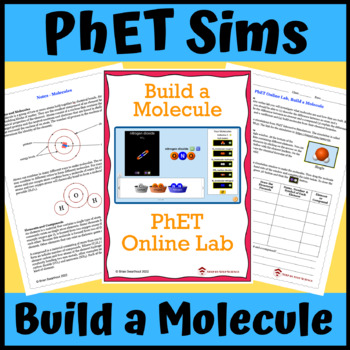
PhET Simulation Online Lab: Build a Molecule
In this guided inquiry two part lab your students will investigate molecules and how they are built. This activity is designed for use with the Build a Molecule HTML5 simulation from PhET Interactive Simulations. The link for the simulation is: https://tinyurl.com/2p9cvvjx. The learning goals for this activity are:(1) Students will be able to explain the difference between an atom and a molecule.(2) Students will be able to explain the difference between an element and a compound.(3) Students wi
Subjects:
Grades:
7th - 12th, Higher Education, Adult Education
Types:
Also included in: Growing Bundle: PhET Simulations Online Physics and Chemistry Labs

Virtual Lab - Exothermic Vs. Endothermic Reactions
Add this virtual lab to your science classroom as an easy way to provide your students with a lab practical! Great to use when you have students who miss a lab, students who are quarantined, or students who are virtual learners. This could also be used as an extra credit assignment!In this lab, students look at 4 different reactions and classify them as exothermic or endothermic by gathering qualitative data and quantitative data. Students will also practice balancing equations, identifying exot
Subjects:
Grades:
6th - 12th
NGSS:
HS-PS1-4

Forensic Science Chromatography Crime Scene Investigation (CSI) Fun Activity
Looking for fun end of the year activities, middle school teacher? Introduce your students to chemistry in forensics and how investigators use chemistry (chromatography) in forensics to solve crimes. You will definitely want to add this not-so-scary, hands-on experiment to your list of mock crime scene investigations (CSI) activities. Your upper elementary or middle school students will love this mock crime scene classroom activity! This activity was designed for my homeschool co-op, but it can
Subjects:
Grades:
5th - 9th
NGSS:
5-PS1-3
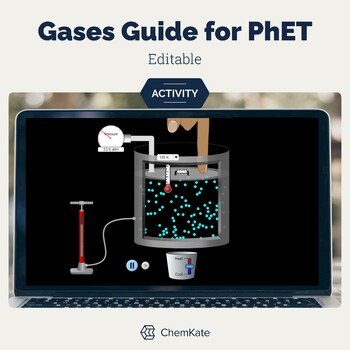
Gases PhET editable Activity Guide for PhET simulation
Teaching gases? This editable PhET particle-diagram activity guide for the award-winning site by University of Colorado - Boulder, a free, interactive, research-based simulation States of Matter: Basics. Get your students involved with manipulating matter at a level they cannot see and make the invisible visible. An excellent bridge into the study of gas chemistry.This activity guide asks students to:Compare solids/liquids/gases in terms of the arrangement & motion of particlesCompare how di
Subjects:
Grades:
7th - 12th, Higher Education, Adult Education
Types:
Also included in: Gases Chemistry Activity and Lab Bundle print and digital
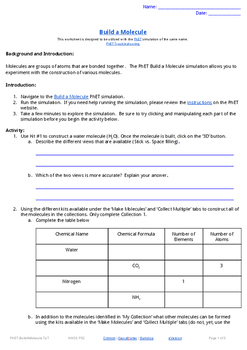
PhET - Build A Molecule
This worksheet aligns with the PhET simulation of the same name.
PhET, founded in 2002 by a Nobel Laureate, develops web-based math and science simulations. PhET is currently among one of the most utilized sources for science and math teachers using interactive simulations.
The Build A Molecule simulation and worksheet takes students through activities designed to build and deepen understanding of how atoms arrange themselves to form simple molecules.
A free digital version of the wo
Subjects:
Grades:
7th - 12th
Types:
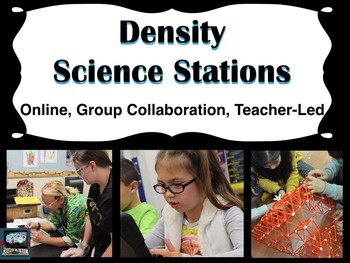
Density Science Stations (online, group collaboration, teacher-led)
Density science stations This density blended learning rotation station incorporates an online simulation station, group collaboration station, and a teacher-led station. You can do all three density stations or pick and choose the stations you want your students to investigate. No matter which station they choose they all will help students understand what determines the ability for an object to float or sink.**SAVE WITH BUNDLES. Two ways to save. Get the Measuring matter bundle or combine the
Subjects:
Grades:
4th - 10th
Types:
Also included in: Measuring Matter (Density, volume, mass) Activities Lessons and More
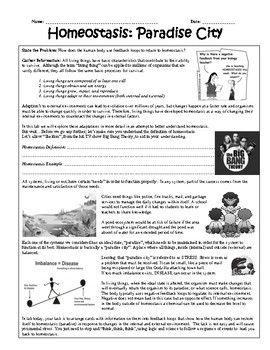
Homeostasis: Paradise City
Students learn HOMEOSTASIS through the creation and logical thinking of FEEDBACK LOOPS. The hands on manipulation of biological chemical processes in the human body allows for simulation of controlling internal body systems. The lab combines examples, visuals, vocabulary, and hands on learning.A high interest, fun, hands on lab experience for students ranging from 6th-12th grade. Use as either an introduction or a review of the concept. The experience has built in ENL and special education modif
Subjects:
Grades:
6th - 12th

Gas Laws Phet Simulation
Enhance your students' understanding of the fundamental Gas Laws - Boyle's Law, Gay-Lussac's Law, Charles's Law, and the Ideal Gas Law - with this engaging and comprehensive PhET simulation activity. Designed for middle and high school science classrooms, this 2-page simulation provides an immersive virtual environment where students can explore the behavior of gases and solidify their conceptual understanding through interactive experiments.This meticulously crafted resource features 27 thought
Subjects:
Grades:
7th - 10th
Types:
Also included in: Gas Laws Mega Bundle: Notes, Simulation, Worksheets, Quiz
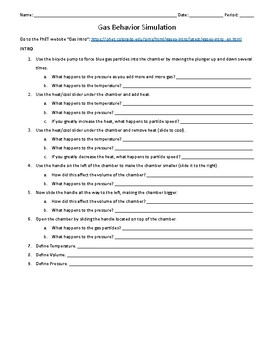
Intro to Gas Behavior - Simulation (with Key)
Use this handout to introduce how gases behave alongside a PhET simulation. Students will learn about conceptual gas behavior, develop personal definitions of volume, pressure, and temperature, as well as explore the following gas laws: Boyle's, Charles', Gay-Lussac's, and Combined Gas Law. Activity is self-guided and a great start to your gas unit.
Subjects:
Grades:
6th - 12th, Higher Education, Adult Education
Types:
Also included in: Gas Laws Bundle
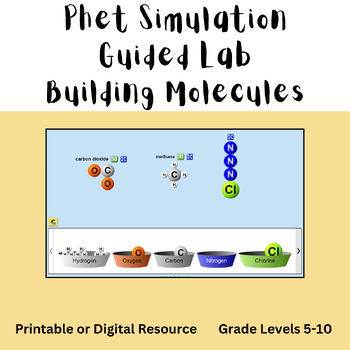
Build a Molecule (w/ Atoms) Phet Simulation (Guided Lab) Printable + Digital
CLICK HERE to access the Energy Forms and Changes Phet Simulation that is utilized for this activity. This activity/lab focuses on Atoms, Molecules, Elements, Chemical Formulas, Subscripts, Coefficients, and Building Models of Molecules.This activity can be used as a digital resource or a printable resource in conjunction with the digital laboratory simulation. It is a fully customizable Google Doc if you want to adjust parts to make it more suitable for your students. It requires NO PREP! The d
Subjects:
Grades:
5th - 10th
Types:
NGSS:
5-PS1-1
, MS-PS1-1
Also included in: Phet Simulation Lab - Growing Bundle (7 Activities Included)
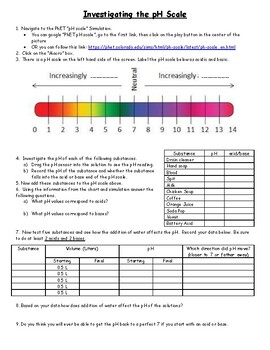
Acid/Base Webquest to accompany pHet website
This is a basic worksheet that introduces the concept of pH scale to accompany the pHet pH scale website. https://phet.colorado.edu/en/simulation/ph-scale This worksheet walks students through the basics of the pH scale and the beginnings of neutralization reactions. Also includes a short reading that allows students to take independent notes about Acids and Bases.
Subjects:
Grades:
6th - 9th
Types:
Also included in: Physical Science Testing Review Bundle
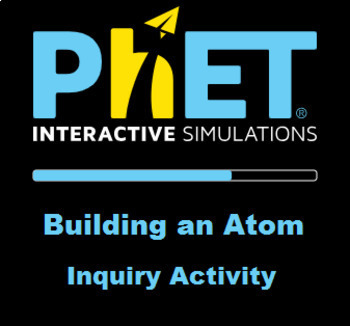
PhET: Building an Atom - Inquiry Virtual Lab for Atomic Structure
This handout guides students through the virtual lab "Building an Atom" simulation found for free at phet.colorado.edu. This activity works well as the "explore" phase of the 5e model for a unit on atomic structure or as a quick review for students who have learned atomic structure before.This is an inquiry-based approach to the simulation, where students are directed to play around and determine which subatomic particles (protons, neutrons, and electrons) affect the mass, charge, and name of a
Subjects:
Grades:
7th - 12th
Types:

Phet Simulation Guided Lab - Balancing Equations- Digital or Printable
CLICK HERE to access the Balancing Chemical Equations Phet Simulation that is utilized for this activity. This activity is printable or it can be used as a digital resource. It requires NO PREP! Students will need access the internet to utilize the Phet Simulation in order to complete this guided exploration activity. This includes multiple screenshots and clear guidance of how to utilize the simulation to ensure students grasp all potential learning opportunities. This was designed for use
Subjects:
Grades:
3rd - 12th, Higher Education, Adult Education, Staff
Types:
NGSS:
MS-PS1-2
, HS-PS1-7
, MS-PS1-5
, MS-PS1-1
Also included in: Phet Simulation Lab - Growing Bundle (7 Activities Included)
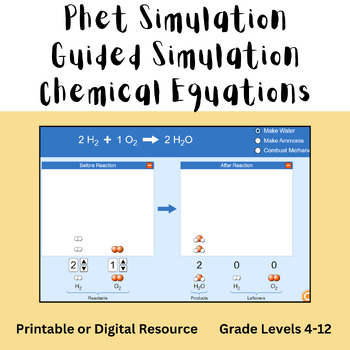
Phet Simulation Guided Lab - Reactant + Product - Digital or Printable
CLICK HERE to access the Reactants, Products, and Leftovers Phet Simulation that is utilized for this activity. This activity is printable or it can be used as a digital resource. It requires NO PREP! Students will need access the internet to utilize the Phet Simulation in order to complete this guided exploration activity. This includes multiple screenshots and clear guidance of how to utilize the simulation to ensure students grasp all potential learning opportunities. This was designed f
Subjects:
Grades:
3rd - 12th, Higher Education, Adult Education, Staff
Types:
NGSS:
5-PS1-4
, MS-PS1-2
, 5-PS1-1
, HS-PS1-7
, MS-PS1-5
...
Also included in: Phet Simulation Lab - Growing Bundle (7 Activities Included)
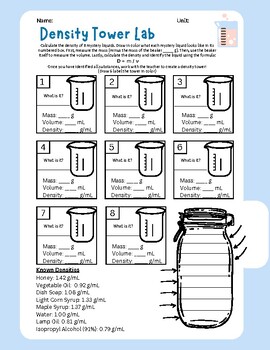
Density Tower Lab
Calculate the density of 8 mystery liquids. Draw in color what each mystery liquid looks like in its numbered box. First, measure the mass (minus the mass of the beaker ____ g). Then, use the beaker itself to measure the volume. Lastly, calculate the density and identify the liquid using the formula: D = m / vOnce you have identified all substances, work with the teacher to create a density tower! (Draw & label the tower in color)
Subjects:
Grades:
5th - 12th
NGSS:
MS-PS1-2
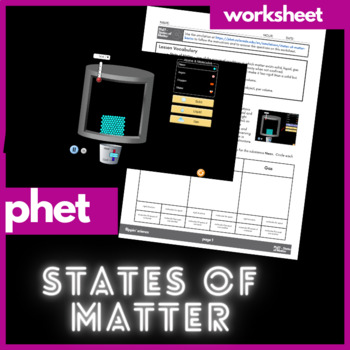
PhET - States of Matter Worksheet
This engaging and interactive worksheet walks the student through the PhET simulation States of Matter as they explore how solid, liquid and gas changes state, and the structural changes that happen along the way.You will use the PhET simulation States of Matter to predict, experiment, discover and interpret the meaning of the physical state of matter.ObjectivesBe able to differentiate the 3 states of matter based on their physical structure.Be able to predict how states change when heat is adde
Subjects:
Grades:
7th - 10th
Types:
NGSS:
MS-PS1-4
Also included in: PhET | States of Matter - Bundle
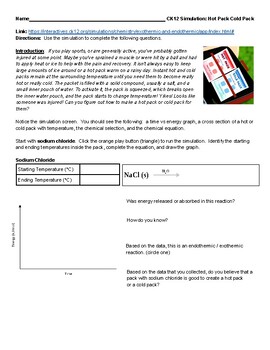
Endothermic and Exothermic Reactions Simulation
Aligned with NGSS: MS-PS1-6 Undertake a design project to construct, test, and modify a device that either releases or absorbs.This simulation guides students with questions related to how chemical reactions occur inside hot packs and cold packs; based on the data and graph, students will interpret whether the chemical reaction was endothermic or exothermic. This simulation is great for independent exploration, guided practice, blended learning, and a quick print for sub plans!
Subjects:
Grades:
6th - 8th
Types:
NGSS:
MS-PS1-6

Covalent Bonding Simulation
Aligned with NGSS: HS-PS1-1 Use the periodic table as a model to predict the relative properties of elements based on the patterns of electrons in the outermost energy level of atoms.This simulation guides students with questions related to how covalent bonds form, what happens to the electrons within covalent bonds, different types of covalent bonds, and how to write the names of covalent compounds. This simulation is great for independent exploration, guided practice, blended learning, and a
Subjects:
Grades:
7th - 10th
Types:
NGSS:
HS-PS1-1
Showing 1-24 of 55 results









